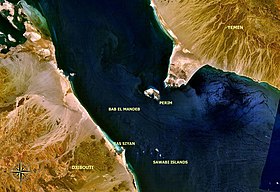Bab-el-Mandeb

The Bab-el-Mandeb, alternatively Bab el Mandab, Bab al Mandab, or Bab al Mandeb meaning "Gate of Tears" in Arabic (باب المندب), is the strait separating the continents of Asia (Yemen on the Arabian Peninsula) and Africa (Djibouti, north of Somalia on the Horn of Africa), and connecting the Red Sea to the Indian Ocean (Gulf of Aden). It is sometimes called the Mandab Strait in English.
Overview
The strait derives its name from the dangers attending its navigation, or, according to an Arab legend, from the numbers who were drowned by the earthquake which separated Asia and Africa. It is also called "The Bridge of Tears", the Arabic translation in Jules Verne's book Around the World in Eighty Days (page 30). It is both strategically important and one of the world's busiest shipping lanes.
The distance across is about 20 miles (30 km) from Ras Menheli on the Arabian coast to Ras Siyan on the African. The island of Perim divides the strait into two channels, of which the eastern, known as the Bab Iskender (Alexander's Strait), is 2 miles (3 km) wide and 16 fathoms (30 m) deep, while the western, or Dact-el-Mayun, has a width of about 16 miles (25 km) and a depth of 170 fathoms (310 m). Near the African coast lies a group of smaller islands known as the "Seven Brothers." There is a surface current inwards in the eastern channel, but a strong undercurrent outwards in the western channel.
According to the recent single origin hypothesis, the straits of Bab-el-Mandeb were probably witness to the earliest migrations of modern humans out of Africa, which occurred roughly 60,000 years ago.[1][2] At this time the oceans were much lower, and the straits were much shallower or dry, allowing a series of emigrations along the southern coast of Asia.
According to a Ethiopian Orthodox Tewahedo Church tradition, the straits of Bab-el-Mendeb were witness to the earliest migrations of Semitic Ge'ez speakers into Africa, occurring roughly around the same time as the Hebrew patriarch Jacob[3].
Pre-history
Sometime during the Tertiary period, the Bab el Mandeb closed and the Red Sea dried to an empty, salt-floored sink.
References
- ^ Spencer Wells, The Journey of Man
- ^ Stephen Oppenheimer. The Gates of Grief
- ^ Official website of EOTC
